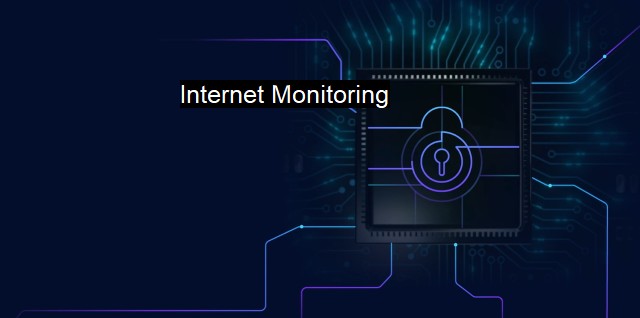What is Internet Monitoring?
Protecting Your Online World: The Importance of Internet Monitoring in Cybersecurity
Internet Monitoring refers to the process of overseeing the activity related to the Internet, performed by individuals or automated services, with the primary purpose of securing digital assets from potential cyber threats. These cyber threats range from hacking attempts, malware, viruses, trojans to phishing attacks, all of which can harm an individual’s or an organization's digital assets or identity.Fundamentally, Internet Monitoring is an active control measure where all incoming and outgoing internet traffic is scanned, and suspicious activities are flagged for further scrutiny. Not only does it allow for a secure digital environment, but it also benefits in maintaining data privacy.
In a wider perspective, Internet Monitoring caters to catering to crucial aspects such as preventing unauthorized access, ensuring compliance with internal and external policies and regulations, bandwidth usage control, and being aware of potential data breaches.
One of the key components of Internet Monitoring is antivirus software. Antivirus programs continuously monitor for threats that could infiltrate by surfing the internet or downloading files. They implement algorithms to detect known malicious patterns in files or incoming data to help prevent software viruses and other malicious cyber threats.
The antivirus programs often use the method of checking the hash sums (unique data signature) of files against their database of known threats to establish the security status of a file or data packet. Matches to known threats trigger antivirus alerts and allow the user or system administrator to quarantine, delete or take another action regarding the threat-posing data. They also function to identify potential zero-day vulnerabilities, which are threats not yet identified by other security measures.
Another aspect of Internet Monitoring lies in the capacity to block illicit content, suspicious URLs, or websites known for hosting malware. This process is generally implemented using filters set on your system or through firewalls that route the internet traffic. These filters can be customized as per the user's requirement to offer customized security schemes.
Internet Monitoring also involves identifying gaps and vulnerabilities that might exist in the software or the system at large. Penetration testing, a subset of internet monitoring, involves ethical hacking methods to probe for potential weak spots in the cyber defense line. If a vulnerability is found, it is logged and addressed by strengthening the existing protections or installing new security protocols.
Other than active monitoring efforts, passive Internet Monitoring revolves around watching the network or its resources for unexpected behavior, anomalies, or policy violations. These could range from heavy bandwidth will consumption, unusual login attempts, accessing sensitive data, and browsing illicit websites – indicative of a security situation. This information is often used to establish baseline normal activity status and flag deviations from the same to identify potential threats or mishaps early on.
Internet Monitoring is an all-encompassing tactic crucial in maintaining robust cybersecurity defenses. It involves granular oversight of all Internet-based activities, backed by various antivirus programs and system-probing methods to keep cyber threats at bay. As internet users and the digital sphere continue to expand, so do cyber threats. Hence, effective and active Internet Monitoring have become more essential than ever to stay one step ahead and secure our digital footprint. It is a cornerstone of cybersecurity, ensuring our data, identities, and virtual lives remain protected always.

Internet Monitoring FAQs
What is internet monitoring?
Internet monitoring refers to the process of keeping an eye on the online activities of users to ensure compliance with security policies and prevent cybersecurity threats. This involves the tracking and analysis of data traffic on networks, websites, and services to detect suspicious behavior or unauthorized access.Why is internet monitoring important for cybersecurity?
Internet monitoring is critical for cybersecurity because it allows organizations to detect and anticipate security threats before they can cause damage. By monitoring internet traffic, organizations can identify and investigate suspicious activity, such as malware infections, phishing attempts, and unauthorized access attempts. This enables organizations to take prompt action to prevent cyber attacks and minimize the impact of security incidents.What are the benefits of internet monitoring?
The benefits of internet monitoring include enhanced cybersecurity, improved regulatory compliance, increased productivity, and reduced liability. By monitoring online activities, organizations can detect and prevent security threats, ensure compliance with industry regulations and internal policies, and identify opportunities for process improvement. Additionally, internet monitoring can help organizations identify and address potential liability issues related to employee misconduct or data breaches.What are the best practices for internet monitoring?
The best practices for internet monitoring include establishing clear security policies and procedures, identifying critical data and systems, utilizing advanced threat detection technologies, and implementing effective incident response plans. Organizations should also ensure that their employees are trained on security best practices and aware of the consequences of non-compliance with security policies. Additionally, organizations should conduct regular audits to ensure that their internet monitoring practices are effective and meet compliance requirements.| | A | | | B | | | C | | | D | | | E | | | F | | | G | | | H | | | I | | | J | | | K | | | L | | | M | |
| | N | | | O | | | P | | | Q | | | R | | | S | | | T | | | U | | | V | | | W | | | X | | | Y | | | Z | |
| | 1 | | | 2 | | | 3 | | | 4 | | | 7 | | | 8 | | |||||||